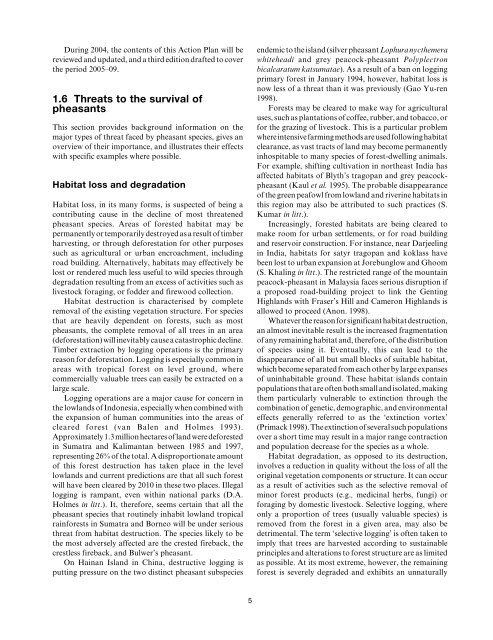Pheasants: Status Survey and Conservation Action Plan ... - IUCN
Pheasants: Status Survey and Conservation Action Plan ... - IUCN
Pheasants: Status Survey and Conservation Action Plan ... - IUCN
You also want an ePaper? Increase the reach of your titles
YUMPU automatically turns print PDFs into web optimized ePapers that Google loves.
During 2004, the contents of this <strong>Action</strong> <strong>Plan</strong> will be<br />
reviewed <strong>and</strong> updated, <strong>and</strong> a third edition drafted to cover<br />
the period 2005–09.<br />
1.6 Threats to the survival of<br />
pheasants<br />
This section provides background information on the<br />
major types of threat faced by pheasant species, gives an<br />
overview of their importance, <strong>and</strong> illustrates their effects<br />
with specific examples where possible.<br />
Habitat loss <strong>and</strong> degradation<br />
Habitat loss, in its many forms, is suspected of being a<br />
contributing cause in the decline of most threatened<br />
pheasant species. Areas of forested habitat may be<br />
permanently or temporarily destroyed as a result of timber<br />
harvesting, or through deforestation for other purposes<br />
such as agricultural or urban encroachment, including<br />
road building. Alternatively, habitats may effectively be<br />
lost or rendered much less useful to wild species through<br />
degradation resulting from an excess of activities such as<br />
livestock foraging, or fodder <strong>and</strong> firewood collection.<br />
Habitat destruction is characterised by complete<br />
removal of the existing vegetation structure. For species<br />
that are heavily dependent on forests, such as most<br />
pheasants, the complete removal of all trees in an area<br />
(deforestation) will inevitably cause a catastrophic decline.<br />
Timber extraction by logging operations is the primary<br />
reason for deforestation. Logging is especially common in<br />
areas with tropical forest on level ground, where<br />
commercially valuable trees can easily be extracted on a<br />
large scale.<br />
Logging operations are a major cause for concern in<br />
the lowl<strong>and</strong>s of Indonesia, especially when combined with<br />
the expansion of human communities into the areas of<br />
cleared forest (van Balen <strong>and</strong> Holmes 1993).<br />
Approximately 1.3 million hectares of l<strong>and</strong> were deforested<br />
in Sumatra <strong>and</strong> Kalimantan between 1985 <strong>and</strong> 1997,<br />
representing 26% of the total. A disproportionate amount<br />
of this forest destruction has taken place in the level<br />
lowl<strong>and</strong>s <strong>and</strong> current predictions are that all such forest<br />
will have been cleared by 2010 in these two places. Illegal<br />
logging is rampant, even within national parks (D.A.<br />
Holmes in litt.). It, therefore, seems certain that all the<br />
pheasant species that routinely inhabit lowl<strong>and</strong> tropical<br />
rainforests in Sumatra <strong>and</strong> Borneo will be under serious<br />
threat from habitat destruction. The species likely to be<br />
the most adversely affected are the crested fireback, the<br />
crestless fireback, <strong>and</strong> Bulwer’s pheasant.<br />
On Hainan Isl<strong>and</strong> in China, destructive logging is<br />
putting pressure on the two distinct pheasant subspecies<br />
endemic to the isl<strong>and</strong> (silver pheasant Lophura nycthemera<br />
whiteheadi <strong>and</strong> grey peacock-pheasant Polyplectron<br />
bicalcaratum katsumatae). As a result of a ban on logging<br />
primary forest in January 1994, however, habitat loss is<br />
now less of a threat than it was previously (Gao Yu-ren<br />
1998).<br />
Forests may be cleared to make way for agricultural<br />
uses, such as plantations of coffee, rubber, <strong>and</strong> tobacco, or<br />
for the grazing of livestock. This is a particular problem<br />
where intensive farming methods are used following habitat<br />
clearance, as vast tracts of l<strong>and</strong> may become permanently<br />
inhospitable to many species of forest-dwelling animals.<br />
For example, shifting cultivation in northeast India has<br />
affected habitats of Blyth’s tragopan <strong>and</strong> grey peacockpheasant<br />
(Kaul et al. 1995). The probable disappearance<br />
of the green peafowl from lowl<strong>and</strong> <strong>and</strong> riverine habitats in<br />
this region may also be attributed to such practices (S.<br />
Kumar in litt.).<br />
Increasingly, forested habitats are being cleared to<br />
make room for urban settlements, or for road building<br />
<strong>and</strong> reservoir construction. For instance, near Darjeeling<br />
in India, habitats for satyr tragopan <strong>and</strong> koklass have<br />
been lost to urban expansion at Jorebunglow <strong>and</strong> Ghoom<br />
(S. Khaling in litt.). The restricted range of the mountain<br />
peacock-pheasant in Malaysia faces serious disruption if<br />
a proposed road-building project to link the Genting<br />
Highl<strong>and</strong>s with Fraser’s Hill <strong>and</strong> Cameron Highl<strong>and</strong>s is<br />
allowed to proceed (Anon. 1998).<br />
Whatever the reason for significant habitat destruction,<br />
an almost inevitable result is the increased fragmentation<br />
of any remaining habitat <strong>and</strong>, therefore, of the distribution<br />
of species using it. Eventually, this can lead to the<br />
disappearance of all but small blocks of suitable habitat,<br />
which become separated from each other by large expanses<br />
of uninhabitable ground. These habitat isl<strong>and</strong>s contain<br />
populations that are often both small <strong>and</strong> isolated, making<br />
them particularly vulnerable to extinction through the<br />
combination of genetic, demographic, <strong>and</strong> environmental<br />
effects generally referred to as the ‘extinction vortex’<br />
(Primack 1998). The extinction of several such populations<br />
over a short time may result in a major range contraction<br />
<strong>and</strong> population decrease for the species as a whole.<br />
Habitat degradation, as opposed to its destruction,<br />
involves a reduction in quality without the loss of all the<br />
original vegetation components or structure. It can occur<br />
as a result of activities such as the selective removal of<br />
minor forest products (e.g., medicinal herbs, fungi) or<br />
foraging by domestic livestock. Selective logging, where<br />
only a proportion of trees (usually valuable species) is<br />
removed from the forest in a given area, may also be<br />
detrimental. The term ‘selective logging’ is often taken to<br />
imply that trees are harvested according to sustainable<br />
principles <strong>and</strong> alterations to forest structure are as limited<br />
as possible. At its most extreme, however, the remaining<br />
forest is severely degraded <strong>and</strong> exhibits an unnaturally<br />
5
















